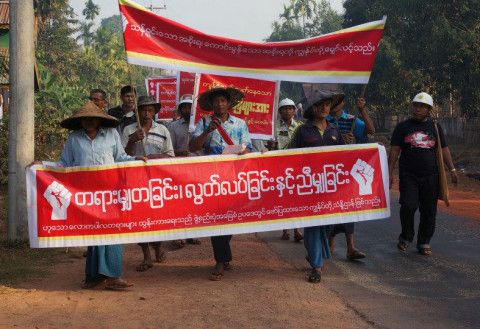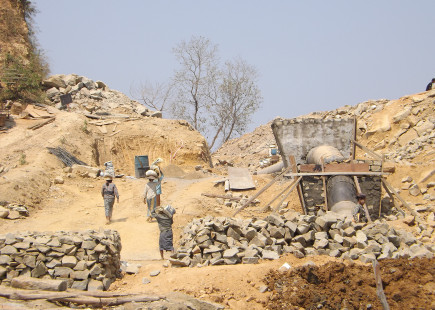Ideas into movement
Boost TNI's work
50 years. Hundreds of social struggles. Countless ideas turned into movement.
Support us as we celebrate our 50th anniversary in 2024.

As the government meets to design a “roadmap” for developing the new national land law, TNI looks at how the situation has changed since the development of the National Land Use policy a few years ago and reflects on the issues at stake for millions of people across the country with rights to land in the current context.

Yukari Sekine
Will the eventual roadmap design entail a quick and superficial process, which would likely end up favoring a pro-business outcome in terms of the content of the new national land law? Or, will it entail a slow and consultative process, which may – if combined with certain other conditions -- increase the chances of a more social justice-oriented outcome? Good process is needed for good outcomes, if that is what we are aiming for. In the current context, a good NLL making process alone will not be sufficient. But it will at least be necessary – alongside other elements – if there can be any hope of overcoming injustice and mistrust to start forging a new path in the longer road to real land reform that is capable of contributing to peace, democracy and justice.
As the year 2019 comes to a close, the struggle over rights to land in Myanmar has reached a new turning point. On December 18-19, 2019, the government will hold a workshop in Nay Pyi Taw to plan the official process (at least on paper) for making a new National Land Law (NLL) – the so-called “NLL Roadmap”.
Whatever its shape and substance, the new land law will eventually clarify the direction the Union government will take the country in not only in terms of rights to land. The new land law will also clarify the terms of “national development” and which development trajectory will be taken, and in so doing, will also clarify who will have to bear the costs of that choice.
As such this meeting may mark the beginning of an important turning point.
Will the eventual roadmap design entail a quick and superficial process, which would likely end up favoring a pro-business outcome in terms of the content of the new national land law? Or, will it entail a slow and consultative process, which may – if combined with certain other conditions -- increase the chances of a more social justice-oriented outcome?
If a new national land law has a chance of being seen as legitimate in the eyes of those whose lives will be most affected by it, then serious attempts will have to be made in the NLL Roadmap to embrace and operationalize the principle of “not about us without us”.
This moment has been in the making ever since the National Land Use Policy (NLUP) was enacted in early 2016, prescribed as it was by that policy. But it has long been envisioned by government actors as a key step in the country’s transition, although just how long ago this moment was conceived is unclear since most of the key decisions related to land and who has rights to it have tended to be tightly controlled by a relatively few players at the top.
The official question right now – which the upcoming roadmap workshop is supposed to go some way towards answering – is this: what kind of design including timeframe will the national land law making process follow?
As ever, this is not merely a technical-procedural question, but a highly political one. We can imagine two broadly distinct scenarios battling it out for the final word.
One possible scenario could be to move as quickly as possible to formulate and enact the new national land law, in order to finally clear the way for new business investors to proceed to operate “free and clear” of any legal impediments -- including “harmonizing” the numerous existing laws and refereeing conflicting land claims between ministries.
In this first scenario, the land problem is ultimately an investment problem that the new land law ought to resolve as soon as possible in favor of helping the country to open up for business as the pathway to economic development. Such a scenario would perhaps get biggest support from the military, the NLD, foreign Chambers of Commerce and other big capital investment players who find the current land situation chaotic from a business perspective, and who view the chief role of state law to facilitate the land deals needed for big corporate driven development.
The other possible scenario would push in the other direction: to lengthen the time frame and bolster a longer process with activities that can satisfy some meaningful measure of public consultation and participation. This kind of process design is needed in order to increase the chances of ending up with a law that is considered legitimate at the level of society and supported by at least a critical mass of the Myanmar public across the whole country. This kind of legitimacy and support is also needed if the NLL Roadmap is to contribute to building ethnic peace.
This second scenario could conceivably be supported by a pretty wide range of actors and organizations. Some might have business interests at heart but at the same time might also be concerned about their company’s reputational risk and/or wanting to avoid appearing to do harm in terms of negative impacts of unregulated land investments. But many if not most supporters of this second scenario would probably envision a more genuinely wide open and exhaustive process that could reach out to deal with pressing social justice issues, problems and concerns. But they are likely to come up against some pretty serious obstacles in bringing this vision to life. Some of these obstacles would be internal to the National Land Law roadmap building process; but many other obstacles would be related to factors way beyond this specific process and therefore far harder to address.
Indeed, the process to design the NLL Roadmap is resurrecting some of the same design issues that arose over the course of the NLUP public consultation process in 2014-2016. In this sense, this moment is the continuation -- “Round 2” -- of the high stakes political battle for the right to land -- and to participate in the decision making that will directly affect their lives -- of millions of rural working people across the country, that began with the NLUP.
But this time, the context is very different.
It has been three years and ten months since the NLUP has been passed. The NLUP remains but a policy with no direct effect in law. In light of the current national government’s failure to take it seriously, its political influence with regard to the new national land law making process appears highly doubtful until proven otherwise. And yet until now, the 2014-2015 NLUP process may be hailed as the most consultative process to date (relatively speaking) which benefitted from involvement – both inside and outside the formal government procedures -- by many civil society organizations and grassroots actors. It should be recalled that the NLUP process started out extremely restricted and with a draft policy that failed completely to reflect the issues, concerns and visions of the vast majority of the country’s most important land stakeholders (See TNI’s Pro-business or Pro-poor? – Making sense of the recently unveiled draft national land use policy). But huge public concern – fueled by rising confiscations and displacements -- served to open up small but significant windows for public participation and comment, thereby leading to a better outcome – very far from perfect, but at least a bit better. Within the extended 8-month consultation period from an initial three-week time, civil society organizations and local NGOs managed to organize around 74 public consultations all over the country with participation from over 5,000 people1. At that time, for a country still in the very initial period of coming out of a straight-up military dictatorship, this was no small step.
Yet the meeting to discuss the roadmap for drafting of the National Land Law, which is taking place this week, is happening in a very different context. For over three years people have been waiting for this moment, but the situation has changed drastically.
In the two years since the NLUP was passed, amended versions of the 2012 Farmland Law, and the Vacant, Fallow, and Virgin (VFV) Land Law were passed despite strong oppositions from the rural and ethnic populations. This reinforcement of the already much-hated VFV Land Law did serious damage to both democracy-building and peace-building (See TNI Commentaries ““A Declaration of War On Us”: The 2018 VFV Law Amendment and its Impact on Ethnic Nationalities” and “Implementation of Burma’s Vacant, Fallow and Virgin Land Management Law: At Odds with the Nationwide Ceasefire Agreement and Peace Negotiations”). Key CSO networks such as Doe Myay (or Land In Our Hands/LIOH in English) devoted many hours to systematically studying these laws and proposing amendments and submitted their ideas to the government (see LIOH’s Statement On The Current Land-Related Laws And Their Amendments). But their ideas were flatly ignored, resulting in an amended VFV Land Law, for example, that is even worse for the majority of rural working people than the original. As of now, 47 million acres of land have been claimed to be vacant, fallow and virgin2, of which around 75% are in the ethnic areas3, waiting to be handed over for business interests. Hundreds of farmers have been criminalized, under these laws. Much trust has been lost; many rural working people across the country have lost faith that this government will act to guarantee their legitimate rights to land.
At the same time, another path towards land reform - the effort to promote national reconciliation and peace has become frozen. Demands from the ethnic armed organisations -- including for meaningful recognition of ethnic customary tenure systems and restitution of the rights to land of IDPs and refugees – have been continuously rejected by the military as beyond the 2008 Constitution and existing laws (including the existing land laws), pushing away from a federal democracy system (See Karen Peace Support Network’s Burma’s Dead End Peace Negotiation Process: A Case Study for Land Sector). Between 2016-2018, over 700 armed clashes have been reported and more than 120,000 people were newly displaced throughout the country.4
In early 2016, Myanmar was still in a moment where “inauguration of a new government chosen by a landslide victory in historic elections offers an unprecedented opportunity to change course” (see TNI Commentary “The right to land at a crossroads in Myanmar” 05 July 2016). Yet this opportunity has largely if not completely been squandered, and in its place, one finds deeper land problems accompanied by deeper doubts and lack of trust than ever.

Thant Zin